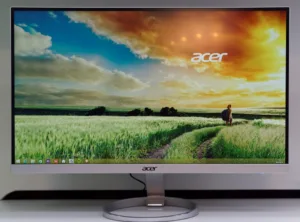Acer showed a new consumer idAcer was in the API area with mobile and monitor products. We have covered the mobile products before, but staff told us that there were new monitors. However, when we checked our databases, we have reported most of them at CES and MWC. The H257U is new to us and is a 25″ 2560 x 1440 monitor with an IPS panel, 4ms response time and DVI, HDMI 2.0 and DisplayPort inputs. Brightness is 350 cd/m2.
Asus was also in the API area, but the products that were new at CeBIT had already been announced at CES and Mobile World Congress.
BOE was on the Chinese Partnership booth and had a number of panels on display including a FullHD panel for medical applications with brightness of 725 cd/m2 and a 27″ 2560 x 1440 panel with 99.8% (how frustrating! – Man. Ed.) of AdobeRGB support and brightness of 350 cd/mm². It uses the QD Vision glass tube-based QDs to achieve the wide gamut and will start to ship in Q2. Already in mass production is a new 23.8″ UltraHD panel with 98% of sRGB gamut. Finally, we looked at a 13.3″ 2560 x 1440 resolution panel for notebooks.
BOE was also highlighting its OGS (One Glass Solution) touch which can support 10 finger touch and uses an ITO electrode pattern on a separate glass sheet, which is produced in BOE’s own factory and can be supplied with panels in an integrated module. It was shown on a 15.6″ notebook panel, but can support sizes from 8″ and a 23.8″ version is “currently waiting for customer qualification”. Standard soda lime glass can be used, or strengthened or Gorilla Glass and anti-reflective and other coatings can be applied according to customer requests.
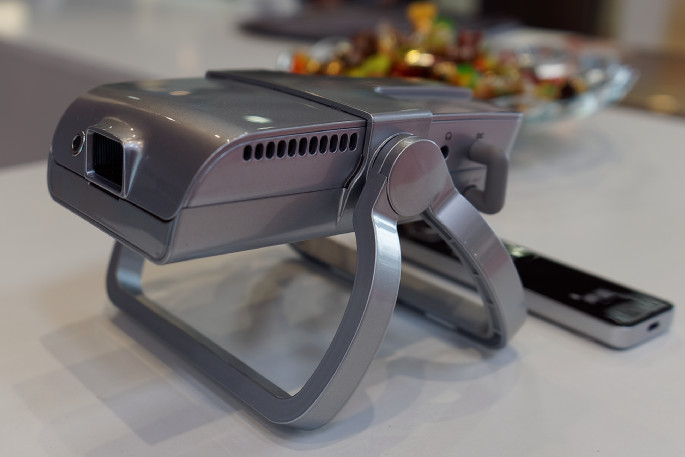 Butterfly has Pico projectors with Android and flexible remotes as well as autofocusButterfly Technology surprised us by saying that it has been at many of the shows that we have reported on over the years, but somehow the firm has slipped through our net (no pun intended!). Butterfly is a Chinese specialist in pico-projection, originally with LCOS imagers, but more recently just with DLP. It started by selling engines to local brands in China, but is now entering the market under its own brand.
Butterfly has Pico projectors with Android and flexible remotes as well as autofocusButterfly Technology surprised us by saying that it has been at many of the shows that we have reported on over the years, but somehow the firm has slipped through our net (no pun intended!). Butterfly is a Chinese specialist in pico-projection, originally with LCOS imagers, but more recently just with DLP. It started by selling engines to local brands in China, but is now entering the market under its own brand.
Products range from 80 ANSI lumens and upwards to 500 lumens and a unique feature is autofocus. There is an embedded camera in the projector that monitors the image during the focusing adjustment and optimises the setting. Projectors also include a full Android implementation (which helps with the camera control) and also a special remote control, based on what the firm calls “G Sensor” technology. Staff were demonstrating the quality of the remote by using it to play Fruit Ninja.
Later this year, Butterfly will introduce wireless streaming to allow mirroring of smartphone and tablet content on the projectors.
CEC of China had a booth on the large main “partner country” booth and was highlighting its ability to produce open cell panels and modules on its G8.5 plant in China. As we have reported over the years, CEC got into the business by acquiring the Sharp G6 Kameyama plant several years ago, and then developed its G8.5 fab, which still has a small share element from Sharp, but CEC is the dominant partner.
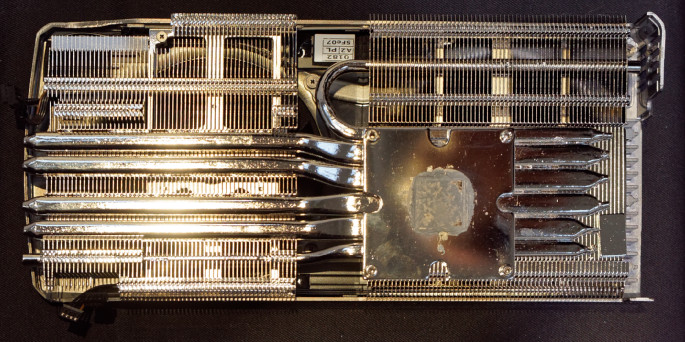 EVGA showed us what it takes to cool one of its high end cards!Our final meeting at CeBIT was with EVGA, the maker of high end graphics cards. The company was showing its Kingpin 4 way SLI card that is said to be a world record holder in terms of overclocking. It’s a while since I looked at this extreme end of the graphics board market and it seems that things have progressed. Apparently, the best way to achieve the extreme overclocking needed to be the fastest, liquid nitrogen is the preferred coolant!
EVGA showed us what it takes to cool one of its high end cards!Our final meeting at CeBIT was with EVGA, the maker of high end graphics cards. The company was showing its Kingpin 4 way SLI card that is said to be a world record holder in terms of overclocking. It’s a while since I looked at this extreme end of the graphics board market and it seems that things have progressed. Apparently, the best way to achieve the extreme overclocking needed to be the fastest, liquid nitrogen is the preferred coolant!
Marginally more accessible is the 980 Hybrid CCS card which uses a closed loop cooling system. Standard liquid cooling systems for graphics cards may be prone to leaks and need the liquid changing on an annual basis, but the Hybrid card uses a factory sealed closed loop cooling system for easier installation and a fully leakproof system. It will be available in April and pricing is being listed at around $800 plus tax in Europe. A new 4GB version of the 960 SSC card is starting to ship today and is available from this week.
EVGA told us that the amount of data involved in supporting UltraHD using multiple graphics cards is a real challenge. We were sworn to secrecy over the details, but suffice it to say that EVGA believes it has an answer.
Fujitsu had several booths, but there was nothing new in client devices, we were told, as we reported on a new tablet from MWC. There were no new displays and we have previously reported on some haptics technology from Fujitsu Japan at MWC and at the Fujitsu Forum. Staff told us that it is getting close to licensing the technology, which is particularly good at emulating different textures on displays, to device makers.
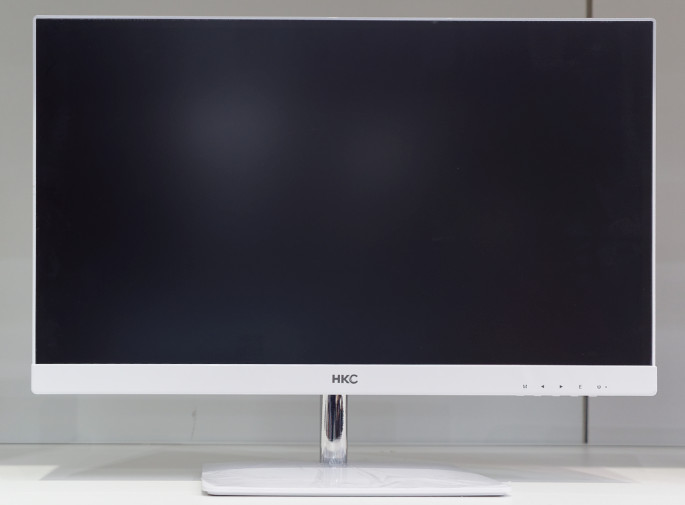 HKC has improved its consumer idHKC had a booth within the API area and a separate one on its own. There is a new industrial design that is more aimed at consumers than the traditional designs from the firm and the new models will be in 21.5″, 23″ and 23.8″ versions. The firm told us that it will be introducing a new 39.5″ UltraHD monitor.
HKC has improved its consumer idHKC had a booth within the API area and a separate one on its own. There is a new industrial design that is more aimed at consumers than the traditional designs from the firm and the new models will be in 21.5″, 23″ and 23.8″ versions. The firm told us that it will be introducing a new 39.5″ UltraHD monitor.
Iiyama told us that it had nothing new, but then put out a press release about two new monitors (Iiyama Expands VA Product Lineup). In line with corporate policy, Iiyama in Germany is focusing on touch. It is happy to sell mainstream monitors, but is not chasing business to simply build turnover. New in Germany was the 55″ procap monitor that we reported on at ISE.
KTC had a booth but no news. “We just have some TVs”, we were told, “but nothing special”. Fantastic marketing!
Optoma had no new updates since ISE, but was showing the UST interactive projector that it had demonstrated there.
RealVNC is a UK-based supplier of remote connection software used for support and remote control operations. It has a number of major contracts including Intel, which uses the firm’s technology to support its VPro PCs. An unusual feature of the software is that linking servers (to link the client to the support worker) can be run within private networks, rather than through public cloud servers, which is appealing to corporates. In addition, the company’s technology can survive reboots and allow remote technicians to access the BIOS settings of remote machines.
As well as PC applications, RealVNC has deals in transport for remote diagnostics and in STBs, including a deal with Comcast. The software is also used for remote access to medical data by GE and Philips Medical. The technology, embedded in scanners, allows a single operator to monitor multiple patients from a single workstation.
At the show RealVNC announced that it has been working with AMD to make use of AMD’s Rapid Fire Pro to access the RealVNC libraries, using the GPU to encode the streams and allowing remote access to virtualised workstations or remote workstations, even running very graphics intensive applications. The technology can be used, for example, to allow skilled workers to access their workstations from home or from remote locations and yet get a fast, low latency, connection to the power of the workstation.
Stino Eyevis was in Hall 2 to promote its special CMS technology for digital signage solutions, which it believes are scalable from small companies to large installations.
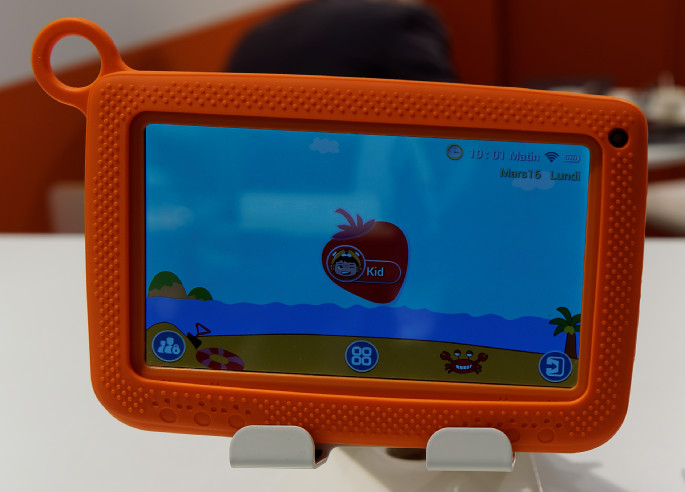 Supertab’s S7Kids tablet was designed for a client in DubaiSuperTab is a Belgian company that can supply tablets under its own brand or with private labels. The company has a range of products available from 7″ to 10″ and with different specifications. It specialises in configuring tablets to fit clients’ requirements. For example, it recently developed the S7Kids tablet following a request from Dubai for a rugged tablet for young users. The company also supplies “everything you need” from cables to earphones and even cases in the box. Despite this, prices are competitive and the S7Kids sells for less than €100 including sales tax. All the tablets run Android.
Supertab’s S7Kids tablet was designed for a client in DubaiSuperTab is a Belgian company that can supply tablets under its own brand or with private labels. The company has a range of products available from 7″ to 10″ and with different specifications. It specialises in configuring tablets to fit clients’ requirements. For example, it recently developed the S7Kids tablet following a request from Dubai for a rugged tablet for young users. The company also supplies “everything you need” from cables to earphones and even cases in the box. Despite this, prices are competitive and the S7Kids sells for less than €100 including sales tax. All the tablets run Android.
We reported on Ultmost at CeBIT 2011 when it showed a prototype projector based on Sony’s SXRD LCOS technology. It is still trying to sell that design, but told us that sales had been slow. Ultmost uses the “Fuss” brand.
More promising areas for Ultmost include mini- and pico-projectors. These have Android built-in and Wi-Fi connectivity and use DLP imagers. There are 10 different versions available depending on specification requests and brightness can be from 50 to 200 Ansi Lumens. Staff told us that a feature of its technology is “complete connectivity” with MicroUSB and SD cards as well as support for Miracast.
Another new product that was said to be getting interest was an ultra short throw (UST) interactive projector, using the company’s own optical pen detection. The projector is said to be selling well in China where the high level of integration is appreciated. The projector has an integrated PC and also a document camera, making it easy to show objects and documents on the display.
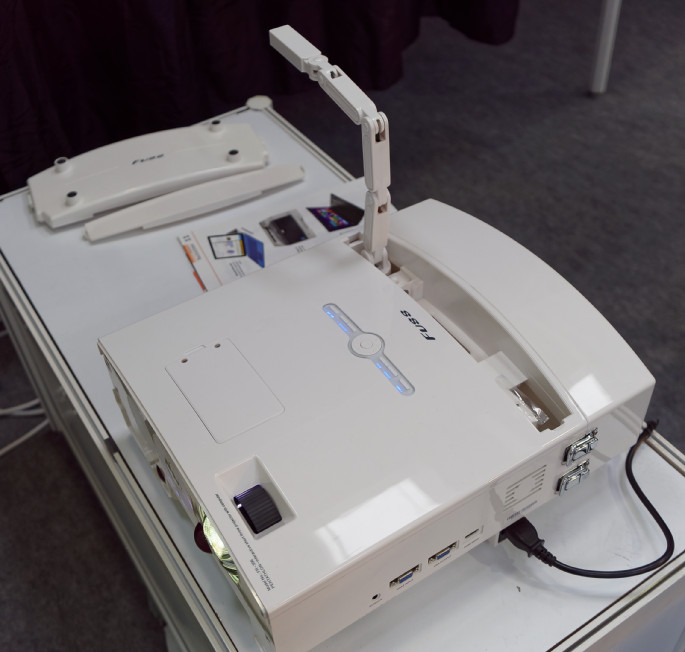 Ultmost’s UST projector has an integrated document camera
Ultmost’s UST projector has an integrated document camera

